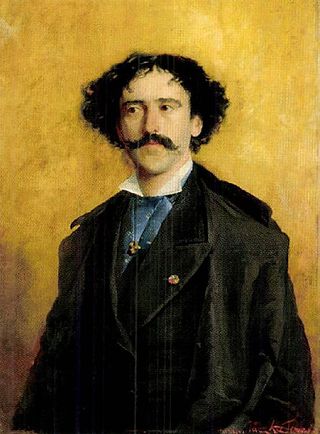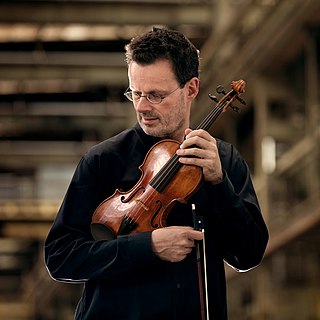
Romani music is the music of the Romani people who have their origins in northern India but today live mostly in Europe.

Pablo Martín Melitón de Sarasate y Navascués, commonly known as Pablo de Sarasate, was a Spanish (Navarrese) violin virtuoso, composer and conductor of the Romantic period. His best known works include Zigeunerweisen, the Spanish Dances, and the Carmen Fantasy.
Verbunkos, other spellings being Verbounko, Verbunko, Verbunkas, Werbunkos, Werbunkosch, Verbunkoche; sometimes known simply as the hongroise or ungarischer Tanz is an 18th-century Hungarian dance and music genre.

The Carmen Fantasy, Op. 25, by Pablo de Sarasate is a fantasy on themes from Bizet's Carmen for violin and piano or orchestra, composed in 1881. A version with piano accompaniment was published in 1882. It was dedicated to Joseph Hellmesberger.

János Bihari was an influential Hungarian Romani violinist. He is one of the founders of Romani academic music and the musical genre verbunkos.
Tzigane is a rhapsodic composition by the French composer Maurice Ravel. It was commissioned by and dedicated to Hungarian violinist Jelly d'Arányi, great-niece of the influential violin virtuoso Joseph Joachim. The original instrumentation was for violin and piano. The first performance took place in London on April 26, 1924 with the dedicatee on violin and with Henri Gil-Marchex at the piano.
Violin Concerto No. 2 in D minor, Op. 22, by the Polish violin virtuoso, Henryk Wieniawski, may have been started in 1856, but the first performance did not take place until November 27, 1862, when he played it in St. Petersburg with Anton Rubinstein conducting. It was published in 1879, inscribed to his dear friend Pablo de Sarasate.

The Trio No. 1 in B-flat major for piano, violin, and cello, D. 898, was written by Franz Schubert in 1827. The composer finished the work in 1828, in the last year of his life. It was published in 1836 as Opus 99, eight years after the composer's death. Like the E-flat major trio, it is an unusually large scale work for piano trio, taking around 40 minutes in total to perform.
The Introduction and Rondo Capriccioso in A minor, Op. 28, is a composition for violin and orchestra written in 1863 by Camille Saint-Saëns. It was dedicated to the virtuoso violinist Pablo de Sarasate, who performed the solo violin part at the premiere in April 1867.

Rudolf Koelman is a Dutch violinist and is professor for violin at the Zürcher Hochschule der Künste (ZHdK) in Switzerland.

"Csárdás" is a rhapsodical concert piece by the Italian composer Vittorio Monti. Written in 1904, the folkloric piece is based on a Hungarian csárdás. It was originally composed for violin, mandolin, or piano. There are arrangements for orchestra and for a number of solo instruments. "Csárdás" is about four-and-a-half minutes in duration.
The term Romani style refers to the way Eastern European music is played in coffeehouses and restaurants, at parties, and sometimes on-stage in European cities. Music played in this style differs from actual Romani music played by Romani and Sinti people, many of whom regard the term "gypsy" as a slur when applied to their community.
Rhapsody No. 1, Sz. 86, 87, and 88, BB 94 is the first of two virtuoso works for violin and piano, written by Béla Bartók in 1928 and subsequently arranged in 1929 for violin and orchestra, as well as for cello and piano. It is dedicated to Hungarian virtuoso violinist Joseph Szigeti, a close friend of Bartók, who gave the first performance of the orchestra version in Königsberg on 1 November 1929, with Hermann Scherchen conducting the orchestra.
Benjamin Britten's Piano Concerto, Op. 13, is the composer's sole piano concerto.
Hungarian Rhapsody No. 13, S.244/13, in A minor, is the thirteenth Hungarian Rhapsody by Franz Liszt. One of the lesser performed works of Liszt, the friska section starts with a theme used by the well-known Allegro molto vivace from Zigeunerweisen by Pablo de Sarasate. At the end, it quotes the authentic Hungarian folk song Nem, nem, nem, nem megyünk mi innen el.

Hungarian Slovak Gypsies or Balshade immigrated to the United States in the late 19th century, many from Košice, Slovakia. They settled in the cities of Braddock, Homestead, Johnstown, and Uniontown, Pennsylvania; Cleveland and Youngstown, Ohio; Detroit and Delray, Michigan; Gary, Indiana; Chicago, and New York City and Las Vegas. The Hungarian Slovak Gypsies were a community of settled Roma, and in the United States were well known for playing music for the Central European immigrant communities in which they settled. These Roma were known for playing in cafes and restaurants, the name associating these Romani as Bashaldé was made up in late 20th century, and in Hungary they are called Romungro Romani; portions of them were also known as Romungre. In the early 1900s the Roma in Braddock, Pennsylvania, purchased an entire block of homes, making them the largest population of settled Roma in the United States.
The Concerto Grosso No. 1 was the first of six concerti grossi by Soviet composer Alfred Schnittke. It was written in 1976–1977 at the request of Gidon Kremer and Tatiana Grindenko who were also the violin soloists at its premiere on 21 March 1977 in Leningrad together with Yuri Smirnov on keyboard instruments and the Leningrad Chamber Orchestra under Eri Klas. It is one of the best-known of Schnittke's polystylistic compositions and marked his break-through in the West.
The String Quartet in D major is the only string quartet composed by César Franck. The work was written from 1889 to 1890.

Concerto for Piano with Orchestra is a piano concerto by the Mexican composer Carlos Chávez, written between 1938 and 1940.

The Spanish Dances are a collection of eight pieces for violin and piano composed by Pablo de Sarasate between 1877 and 1882 and published in four books, each book combining two dances contrasting in rhythm and character. They are among Sarasate's best known works.











